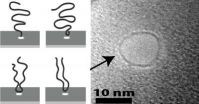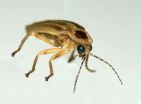(Press-News.org) In a future shaped by climate change, only the strong – or heat-resistant – will survive. A study published in the Proceedings of the National Academy of Sciences opens a window into a genetic process that allows some corals to withstand unusually high temperatures and may hold a key to species survival for organisms around the world.
"If we can find populations most likely to resist climate change and map them, then we can protect them," said study co-author Stephen Palumbi, a senior fellow at the Stanford Woods Institute for the Environment and director of Stanford's Hopkins Marine Station. "It's of paramount importance because climate change is coming."
Coral reefs are crucial sources of fisheries, aquaculture and storm protection for about 1 billion people worldwide. These highly productive ecosystems are constructed by reef-building corals, but overfishing and pollution plus rising temperatures and acidity have destroyed half of the world's reef-building corals during the past 20 years. The onslaught of climate change makes it imperative to understand how corals respond to extreme temperatures and other environmental stresses.
Although researchers have observed that certain corals withstand stresses better than others, the molecular mechanisms behind this enhanced resilience remain unclear. For their study, Palumbi,
lead author Daniel Barshis, a Stanford postdoctoral scholar, and other researchers looked at shallow-reef corals off Ofu Island in American Samoa to determine how they survive waters that often get hotter than 32 degrees Celsius / 90 degrees Fahrenheit during summer-time low tides.
Utilizing cutting edge DNA sequencing technology, the scientists examined the corals' gene expression when subjected to water temperatures up to 35 degrees Celsius / 95 degrees Fahrenheit. "These technologies are usually applied to human genome screens and medical diagnoses, but we're now able to apply them to the most pressing questions in coral biology, like which genes might help corals survive extreme heat," said Barshis.
Heat-resistant and heat-sensitive corals had a similar reaction to experimental heat: hundreds of genes "changed expression" or turned on to reduce and repair damage. However, the heat-resistant corals showed an unexpected pattern: 60 heat stress genes were already turned on even before the experiment began. These genes are "frontloaded" by heat resistant corals – already turned on and ready to work even before the eat stress began. "It's like already having your driver's license and boarding pass out when you get close to the TSA screener at the airport, rather than starting to fumble through your wallet once you get to the front of the line," Palumbi said.
The findings show that DNA sequencing can offer broad insights into the differences that may allow some organisms to persist longer amid future changes to global climate. "We're going to put a lot of effort into protecting coral reefs, but what happens if we wake up in 30 years and all our efforts are in vain because those corals have succumbed to climate change," Palumbi said.
As with strong corals, finding species most likely to endure climate change – "resilience mapping" – is the first step toward protecting them, Palumbi said. "The solutions that we're looking for must, at least partially, be out there in the world."
###
Study: http://www.pnas.org/content/early/2013/01/02/1210224110.abstract
Contact
Stephen Palumbi, Stanford Woods Institute for the Environment: cell, 831-601-7002; office, 831-655-6210; spalumbi@stanford.edu
Dan Barshis, National Marine Fisheries Service: office, 831-420-3957; daniel.barshis@noaa.gov
Rob Jordan, Stanford Woods Institute for the Environment: office, 650-721-1881; rob.jordan@stanford.edu
Heat-resistant corals provide clues to climate change survival
2013-01-08
ELSE PRESS RELEASES FROM THIS DATE:
Cheap and easy technique to snip DNA could revolutionize gene therapy
2013-01-08
A simple, precise and inexpensive method for cutting DNA to insert genes into human cells could transform genetic medicine, making routine what now are expensive, complicated and rare procedures for replacing defective genes in order to fix genetic disease or even cure AIDS.
Discovered last year by Jennifer Doudna and Martin Jinek of the Howard Hughes Medical Institute and University of California, Berkeley, and Emmanuelle Charpentier of the Laboratory for Molecular Infection Medicine-Sweden, the technique was labeled a "tour de force" in a 2012 review in the journal ...
Space-simulation study reveals sodium rhythms in the body
2013-01-08
Maintaining the right sodium levels in the body is crucial for controlling blood pressure and ensuring proper muscle function. Conventional wisdom has suggested that constant sodium levels are achieved through the balance of sodium intake and urinary excretion, but a new study in humans published by Cell Press on January 9th in the journal Cell Metabolism reveals that sodium levels actually fluctuate rhythmically over the course of weeks, independent of salt intake. This one-of-a-kind study, which examined cosmonauts participating in space-flight simulation studies, challenges ...
Most physicians do not meet Medicare quality reporting requirements
2013-01-08
Washington, DC – A new Harvey L. Neiman Health Policy Institute study shows that fewer than one-in-five healthcare providers meet Medicare Physician Quality Reporting System (PQRS) requirements. Those that meet PQRS thresholds now receive a .5 percent Medicare bonus payment. In 2015, bonuses will be replaced by penalties for providers who do not meet PQRS requirements. As it stands, more than 80 percent of providers nationwide would face these penalties.
Researchers analyzed 2007-2010 PQRS program data and found that nearly 24 percent of eligible radiologists qualified ...
Genes and obesity: Fast food isn't only culprit in expanding waistlines -- DNA is also to blame
2013-01-08
Researchers at UCLA say it's not just what you eat that makes those pants tighter — it's also genetics. In a new study, scientists discovered that body-fat responses to a typical fast-food diet are determined in large part by genetic factors, and they have identified several genes they say may control those responses.
The study is the first of its kind to detail metabolic responses to a high-fat, high-sugar diet in a large and diverse mouse population under defined environmental conditions, modeling closely what is likely to occur in human populations. The researchers ...
Brief class on easy-to-miss precancerous polyps ups detection, Mayo study shows
2013-01-08
JACKSONVILLE, Fla. — Most people know a colonoscopy requires some preparation by the patient. Now, a Mayo Clinic physician suggests an additional step to lower the risk of colorectal cancer: Ask for your doctor's success rate detecting easy-to-miss polyps called adenomas.
The measure of success is called the adenoma detection rate, or ADR, and has been linked to a reduced risk of developing a new cancer after the colonoscopy. The current recommended national benchmark is at least 20 percent, which means that an endoscopist should be able to detect adenomas in at least ...
New research may explain why obese people have higher rates of asthma
2013-01-08
New York, NY — A new study led by Columbia University Medical Center (CUMC) researchers has found that leptin, a hormone that plays a key role in energy metabolism, fertility, and bone mass, also regulates airway diameter. The findings could explain why obese people are prone to asthma and suggest that body weight–associated asthma may be relieved with medications that inhibit signaling through the parasympathetic nervous system, which mediates leptin function. The study, conducted in mice, was published in the online edition of the journal Cell Metabolism.
"Our study ...
Simulated Mars mission reveals body's sodium rhythms
2013-01-08
Clinical pharmacologist Jens Titze, M.D., knew he had a one-of-a-kind scientific opportunity: the Russians were going to simulate a flight to Mars, and he was invited to study the participating cosmonauts.
Titze, now an associate professor of Medicine at Vanderbilt University, wanted to explore long-term sodium balance in humans. He didn't believe the textbook view – that the salt we eat is rapidly excreted in urine to maintain relatively constant body sodium levels. The "Mars500" simulation gave him the chance to keep salt intake constant and monitor urine sodium levels ...
Researchers identify new target for common heart condition
2013-01-08
Researchers have found new evidence that metabolic stress can increase the onset of atrial arrhythmias, such as atrial fibrillation (AF), a common heart condition that causes an irregular and often abnormally fast heart rate. The findings may pave the way for the development of new therapies for the condition which can be expected to affect almost one in four of the UK population at some point in their lifetime.
The British Heart Foundation (BHF) study, led by University of Bristol scientists and published in Circulation: Arrhythmia and Electrophysiology, found that metabolic ...
DNA prefers to dive head first into nanopores
2013-01-08
PROVIDENCE, R.I. [Brown University] — If you want to understand a novel, it helps to start from the beginning rather than trying to pick up the plot from somewhere in the middle. The same goes for analyzing a strand of DNA. The best way to make sense of it is to look at it head to tail.
Luckily, according to a new study by physicists at Brown University, DNA molecules have a convenient tendency to cooperate.
The research, published in the journal Physical Review Letters, looks at the dynamics of how DNA molecules are captured by solid-state nanopores, tiny holes that ...
Scientists mimic fireflies to make brighter LEDs
2013-01-08
The nighttime twinkling of fireflies has inspired scientists to modify a light-emitting diode (LED) so it is more than one and a half times as efficient as the original. Researchers from Belgium, France, and Canada studied the internal structure of firefly lanterns, the organs on the bioluminescent insects' abdomens that flash to attract mates. The scientists identified an unexpected pattern of jagged scales that enhanced the lanterns' glow, and applied that knowledge to LED design to create an LED overlayer that mimicked the natural structure. The overlayer, which increased ...



